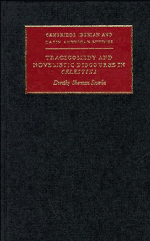Book contents
- Frontmatter
- Contents
- List of illustrations
- Preface
- Abbreviations
- 1 Introduction: Celestina and novelistic discourse
- 2 The prefatory material: the author's ambivalent intentions
- 3 Genre and the parody of courtly love
- 4 From parody to satire: clerical and estates satire
- 5 Verbal humour and the legacy of stagecraft
- 6 The rhetorical shift from comedy to tragedy: ironic foreshadowing and premonitions of death
- 7 Is Melibea a tragic figure?
- 8 Pleberio's lament, Cárcel de Amor, and the Corbacho
- 9 Conclusion: Rojas' ambivalence towards literature
- Notes
- Bibliography
- Index
- CAMBRIDGE IBERIAN AND LATIN AMERICAN STUDIES
1 - Introduction: Celestina and novelistic discourse
Published online by Cambridge University Press: 05 March 2012
- Frontmatter
- Contents
- List of illustrations
- Preface
- Abbreviations
- 1 Introduction: Celestina and novelistic discourse
- 2 The prefatory material: the author's ambivalent intentions
- 3 Genre and the parody of courtly love
- 4 From parody to satire: clerical and estates satire
- 5 Verbal humour and the legacy of stagecraft
- 6 The rhetorical shift from comedy to tragedy: ironic foreshadowing and premonitions of death
- 7 Is Melibea a tragic figure?
- 8 Pleberio's lament, Cárcel de Amor, and the Corbacho
- 9 Conclusion: Rojas' ambivalence towards literature
- Notes
- Bibliography
- Index
- CAMBRIDGE IBERIAN AND LATIN AMERICAN STUDIES
Summary
The characters of Celestina essentially occupy inner space, rather than living outdoors in linear space. The scenes of Celestina take place in people's houses and gardens and not on the open road, in contrast with the chivalric romance, or the later picaresque genre, or Don Quixote, where interiors exist but are not the rule. This may be explained by Celestina's genesis in the humanistic comedy and the sentimental romance. Arnalte's ‘triste morada’ [sad dwelling] in the Tratado de amoves de Arnaltey Lucenda, or Leriano's jail of love in Cárcel de Amor, prefigure Celestina, although the later book's houses are only incidentally allegorical or symbolic. Celestina shows in its use of inner space a curious parallel with the nineteenth-century novel which occurs indoors, though we might equally cite the initial requirements of stagecraft (the humanistic comedy which influences the author of Act I) as predisposing the book to interiors. Celestina's brothel and laboratory, Pleberio's mansion and Melibea's garden, Calisto's house and stable, are the background against which the voices of Celestina meet and speak. The anti-heroic Celestina herself is seen sallying forth on the open road, occasionally with her picaresque Sancho, Sempronio, but she leaves her own house to proceed to Melibea's and then back again, or to Calisto's to report her success. Pármeno and Calisto also travel to and from their assignations with their respective women, but the boudoir or garden is their goal.
- Type
- Chapter
- Information
- Publisher: Cambridge University PressPrint publication year: 1989



